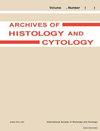大鼠垂体atp敏感K +通道亚基的定位
Q4 Medicine
引用次数: 3
摘要
首先采用RT-PCR和免疫组化染色方法研究大鼠垂体中atp敏感K (KATP)通道Kir6.1、Kir6.2、SUR1、SUR2A和SUR2B亚基。RTPCR分析结果显示,大鼠垂体表达上述5个KATP通道亚基。免疫组织化学染色显示,这些KATP通道亚基广泛分布于不同强度的前叶、中间叶和后叶。免疫荧光双重和三重染色显示,这些KATP通道亚单位与垂体前叶含有促肾上腺皮质激素(ACTH)的细胞共定位。有趣的是,Kir6.1和Kir6.2都没有与含有催乳素(PRL)、促卵泡激素(FSH)和生长激素(GH)的细胞共定位。这些结果表明ACTH细胞包含Kir6.1/SUR2A、Kir6.2/SUR2A、Kir6.1/ SUR2B和Kir6.2/SUR2B四种类型的KATP通道。KATP通道可能在垂体ACTH细胞中起重要作用。促皮质细胞中KATP通道亚基的组成不同,而PRL、FSH和GH细胞中则不同,这可能是由于这些细胞的代谢情况不同所致。本文章由计算机程序翻译,如有差异,请以英文原文为准。
Localization of ATP-sensitive K + channel subunits in rat pituitary gland
ATP-sensitive K (KATP) channel subunits Kir6.1, Kir6.2, SUR1, SUR2A, and SUR2B in the rat pituitary gland were first investigated by RT-PCR assay and immunohistochemical staining. The results of RTPCR analysis showed that the rat pituitary gland expressed the five KATP channel subunits mentioned above. Immunohistochemical staining showed that these KATP channel subunits were widely localized in the anterior lobe, intermediate lobe, and posterior lobe at different intensities. Immunofluorescence double and triple staining showed that these KATP channel subunits colocalized with cells containing adrenocorticotropic hormone (ACTH) in the anterior lobe of the pituitary gland. Interestingly, neither Kir6.1 nor Kir6.2 colocalized with cells containing prolactin (PRL), follicular stimulating hormone (FSH), and growth hormone (GH). These results suggest that ACTH cells contain four types of KATP channels: Kir6.1/SUR2A, Kir6.2/SUR2A, Kir6.1/ SUR2B, and Kir6.2/SUR2B. KATP channels may play some important roles in ACTH cells in the pituitary gland. The different compositions of KATP channel subunits in corticotrophs but not in the PRL, FSH, and GH cells might be due to the different metabolic situations of these cells.
求助全文
通过发布文献求助,成功后即可免费获取论文全文。
去求助
来源期刊

Archives of histology and cytology
生物-细胞生物学
自引率
0.00%
发文量
0
期刊介绍:
The Archives of Histology and Cytology provides prompt publication in English of original works on the histology and histochemistry of man and animals. The articles published are in principle restricted to studies on vertebrates, but investigations using invertebrates may be accepted when the intention and results present issues of common interest to vertebrate researchers. Pathological studies may also be accepted, if the observations and interpretations are deemed to contribute toward increasing knowledge of the normal features of the cells or tissues concerned. This journal will also publish reviews offering evaluations and critical interpretations of recent studies and theories.
 求助内容:
求助内容: 应助结果提醒方式:
应助结果提醒方式:


